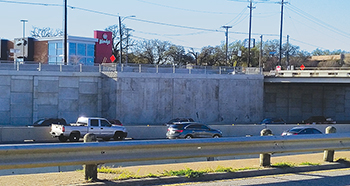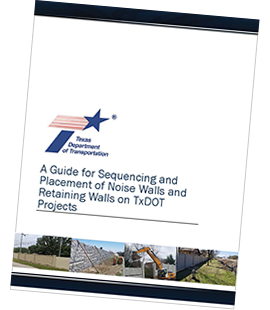A common sight on Texas roadways is noise walls and retaining walls. Noise walls, or barriers, are helpful in keeping the sound of a busy highway out of neighborhoods and business districts. Retaining walls reduce the need for a sloped area at grade changes and are used extensively for highway overpasses.

Noise walls and retaining walls serve different purposes but have similarities in terms of the design and construction process. However, construction of these walls may face issues with utilities, phases of construction, and access. Manuals and design guides mention these concerns but fail to lay out applicable solutions.
Research from the Texas A&M Transportation Institute (TTI) and the Texas Department of Transportation (TxDOT) aims to assist noise wall and retaining wall constructability by resolving issues with sequencing and placement.
“The research started with discussions with TxDOT utility coordination staff at the Dallas and San Antonio Districts,” says Kris Harbin, TTI assistant research scientist. “There were issues between utility relocations and noise wall placements being set in the same area of the right of way.”
Harbin’s study, titled Sequencing and Placement of Noise Walls and Retaining Walls on TxDOT Projects, seeks to provide guidance on the best ways to install these types of walls to benefit ease of travel and save on construction costs.
“A smoother process happens when TxDOT and utility companies work closely to determine where lines are before the project starts,” Harbin says. “You have to make sure you have your ducks in a row during design, or it’s going to cause issues during construction.”
As with many plans, changes will need to be addressed during execution. Existing lines for gas, sewer or other utilities may require TxDOT to rethink the original design.
“One location had a crossing for an existing utility duct bank, which is used to consolidate utility cabling,” Harbin says. “During construction, TxDOT realized the utility was shallower than what the utility company provided to TxDOT, putting it in conflict with the proposed retaining wall. Estimated relocation of the utility would take about two years and cost $2 million; TxDOT decided not to relocate it. It would have been better to clear the conflict during design, but the foundation of the retaining wall was revised during construction to allow the utility facility to stay in place.”

The utility coordination process at TxDOT of avoid, minimize, and accommodate comes into effect: do what is needed to ensure a successful completion of the project.
One result of this research to address problems during design is a guidebook to assist organizations in sequencing and placement of noise walls and retaining walls. The guidebook provides recommendations, preferred methods and best practices for sequencing, placement, design and construction for reducing issues with structures during construction and maintenance.
This 38-page guidebook, condensing the original 420-page research document, is available for use by other departments of transportation.
“I don’t want it to sit on a shelf,” Harbin says. “I want it to get out there and be used. There’s so much good information squeezed down to fit into the guidebook so it’s easier to use.”
Information in the guidebook is divided into sections.
“We laid out the guidebook to make it easy to find the information because we are going to have multiple stakeholders and users of this guidebook,” Harbin says. “If you are looking for noise wall design recommendations, go to page 15. If you’re interested in right of way, go to page 22. If you’re interested in utilities, go to page 19.”
A key benefit of the research is recommendations for designers and other stakeholders. Harbin would also like to work with TxDOT districts to help implement best practices in the guide.
“If we do it right the first time, it’s going to make everyone’s life easier,” Harbin says. “This research makes the process better, not only for a current project but for projects to come.”

